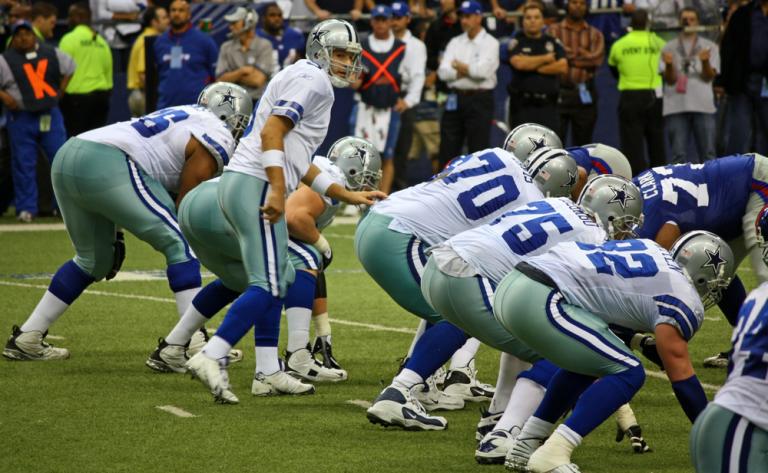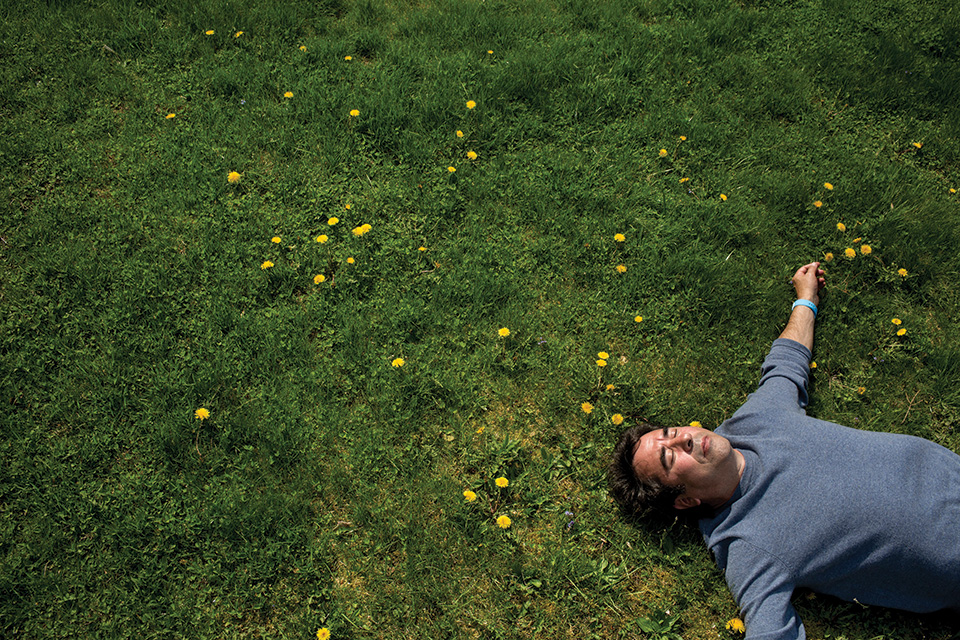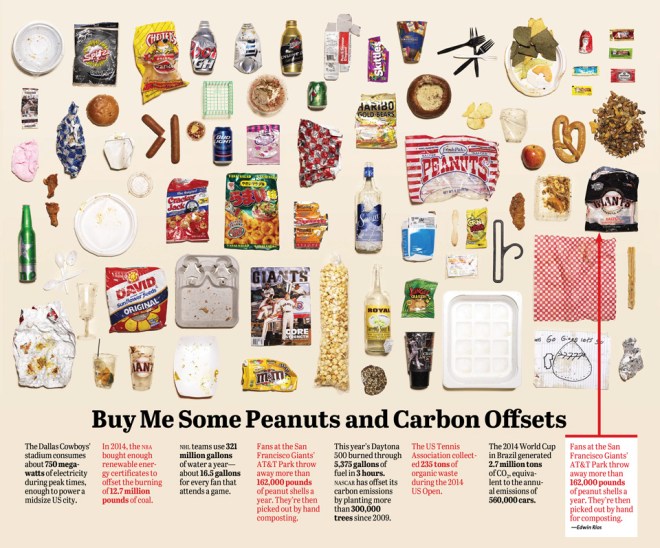This story was originally published by Mother Jones and is reproduced here as part of the Climate Desk collaboration.
IT’S A FOGGY FEBRUARY morning in San Francisco, and a classroom full of midcareer MBA students at the Presidio Graduate School listens, rapt, as Allen Hershkowitz tells his toilet paper story.
Back in 2004, the Philadelphia Eagles had recently moved into a brand new stadium and wanted to become more environmentally responsible. The team reached out to him to talk about paper, one of his areas of expertise. It wasn’t exactly exciting stuff, but Hershkowitz, then a senior scientist at the Natural Resources Defense Council (NRDC) with a track record of taking on ambitious projects, had done his homework: The Eagles’ TP supplier was Kimberly-Clark, which was getting wood pulp from forests in the southern Appalachians that were home to, you guessed it, real-life eagles. “The people at the Eagles’ stadium were wiping their butts with eagle habitat,” he recalls. “That’s what we call a branding liability.”
Standing in front of his Business of Sports and Sustainability class in a gray wool suit with a blue dress shirt unbuttoned to reveal a silver Om pendant, Hershkowitz smiles at the memory. Ever since that meeting more than a decade ago, he has been at the forefront of the sports sustainability movement, first at the NRDC and now at his own group, the Green Sports Alliance (GSA). What started as a one-off win in a football team’s restrooms has morphed into a wide-ranging effort to promote energy efficiency, recycling and composting, better food sourcing, and species preservation — and, beyond all that, to bring environmental messages to America’s sports-crazed masses.
Since it started in 2010, the GSA has enlisted 134 pro sports teams, 142 venues, and nine leagues, including pro baseball, basketball, and hockey. At least 28 venues now use some kind of renewable energy; 20 stadiums have been LEED certified. The National Hockey League has avoided more than 38 million pounds of carbon emissions since 2012 by purchasing offsets and renewable energy certificates. Major League Baseball teams use special software called Green Track to monitor their energy and water use. The National Basketball Association powers its All-Star events and midseason Green Week with renewable energy and has even written to Congress, calling for tighter regulations on coal-fired power plants to help combat climate change.
Much of this can be attributed to the 60-year-old Hershkowitz’s ability to sell sustainability not as an obligation to the planet but as a smart financial move. “If we went to CFOs and were like, ‘We want to talk about global warming,’ they’d be like, ‘Get the fuck out of here,'” he says. “It was all about business and the bottom line.” He recalls one pro football exec telling him, “Allen, I know just by the way you look that I disagree with everything you stand for — but I like working with you because you save us money.”
For Hershkowitz, the bottom line isn’t making owners happy but achieving the biggest possible impact. “This is 100 percent strategic,” he says. Almost every major industry — energy, transportation, food, chemicals, textiles — has a stake in pro sports, either as suppliers or sponsors. Tweak a team’s or a league’s supply chain, and you might change the way an entire chunk of the economy does business. And then there’s the potential to reach millions of fans. “Sixteen percent of Americans follow science,” Hershkowitz says, citing a National Science Foundation survey. “Seventy percent follow sports.” And many of them are not exactly sympathetic to the climate change agenda.
“The question is, how do you change people’s cultural attitudes?” he says. “How do you change their minds? You don’t do it by arguing in Congress. You don’t do it through talking heads on Sunday talk shows. You’ve got to connect with them in a place where they’re open to changing their minds.” And talking people into a place where they’re ready to change their minds is one of Hershkowitz’s talents. “Allen has a very good way of making friends with important people,” says John Adams, the NRDC’s founder. “He’s not a bleeding violet.”
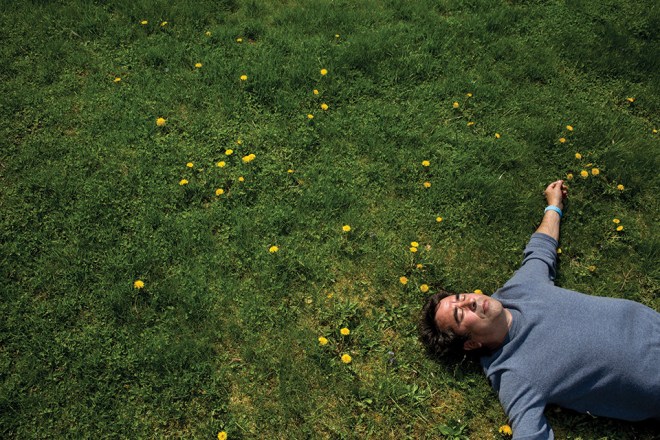
Allen Hershkowitz.Natalie Keyssar/Mother Jones
HERSHKOWITZ IS NOT much of a sports fan, either. Rather, he’s a personable polymath who spits out data, poetry, and the occasional Henry David Thoreau quote. During boozy postclass dinners, he drops names (Elie Wiesel, David Stern, Billie Jean King) and regales his guest speakers and TAs with engaging anecdotes of his exploits. (As his former NRDC colleague Darby Hoover says, “I’m sure you’ve noticed: Allen never exaggerates at all.”) His American Express card IDs him as DR. ALLEN HERSHKOWITZ / SCIENTIST AND POET.
When I first got him on the phone, he peppered me with a dizzying array of factoids and stats. He let me know that there are 154 pro sports teams (“if you don’t include professional lacrosse”), 90 of which share 50 animals as mascots or team names; 31 of those animals are endangered or at risk of going extinct in the wild.
He was always good with numbers, something he attributes, in a roundabout way, to not speaking English until he was 5. “A fact was a fact in Yiddish,” he says, “and a fact was a fact in English.” He was born in Brooklyn, the son of Holocaust survivors who’d both lost spouses and children in the war. They met at a postwar displacement camp and made their way to the United States, eventually starting a new family in Crown Heights’ Orthodox Jewish community.
Hershkowitz attended New York City public schools from kindergarten through grad school at CUNY, where he received a doctorate in political economics in 1986. He became an expert on recycling (“I was the only PhD in garbage!”). In an article on one of his lectures, The New Yorker described him as “a handsome, slightly dishevelled man in a tan suit.”
In 1988, the NRDC brought him in to run its solid-waste program. “He was just full of energy and had a lot of electricity,” Adams recalls. “I thought we had a real live wire.” Hershkowitz remembers Adams telling him, “Don’t do anything illegal, but whatever you do, be effective.” At first, that meant trying to win political battles in Washington, D.C., an experience that left him skeptical of official efforts to enact change. “Water doesn’t freeze at 32 degrees Fahrenheit in Congress,” he says. “It’s all negotiable depending on how much you want to pay them.”
Hershkowitz’s biggest political battle came when he proposed converting a polluted South Bronx rail yard into a high-tech paper mill that would recycle the city’s paper. Hershkowitz lined up big-name boosters, including then-Vice President Al Gore and architect Maya Lin, who agreed to design the plant. But the plan crumbled due to local turf battles and the opposition of Mayor Rudy Giuliani. When The New Yorker covered the fight, it found Hershkowitz “a shaggy-haired and slightly worried-looking man.” He jokes that he needed a second therapist by the time the project was officially dead. “I learned that the ruthlessness of the market does not go away because you have good intentions,” he says. “I learned that there are cultural barriers to sustainability. I learned that nobody has a monopoly on virtue.”
The game-changing moment came in 2004, when Hershkowitz attended a retreat at the Sundance, Utah, home of NRDC trustee Robert Redford. While discussing the Bush administration’s stance on climate change, the conversation turned to the question of recruiting nontraditional allies. “You need to go to the ballpark,” Redford chimed in. “You need to meet people where they’re at.”
A few months later, Hershkowitz secured a meeting with surrogates to then-Major League Baseball Commissioner Bud Selig, to ask them to collaborate with the NRDC on environmental messaging. Redford narrated a $35,000 video the NRDC put together for the meeting, even making an appearance in the New York Knights jacket he famously wore in The Natural. The commish bought in, signing a comprehensive agreement to educate fans and promote energy efficiency, renewable power, water conservation, and recycling. When they finally met in person, Hershkowitz says, Selig took him by the shoulders and said, “Whatever you need, you let me know.” To this day, Hershkowitz calls Selig “the greatest environmentalist in the history of sports.”
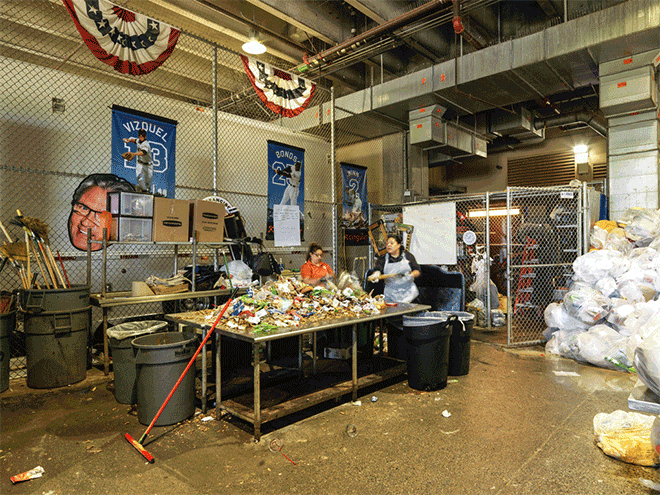
The dirty work of going green: inside the recycling center at the San Francisco Giants’ AT&T Park.Justin Fantl/Mother Jones
Baseball was just the start. Hershkowitz set his sights on the NBA, the NHL, Major League Soccer, the U.S. Tennis Association, the National Lacrosse League, cricket, Australian rules football, Cincinnati’s Flying Pig Marathon, you name it. He perfected the art of nudging reluctant officials and owners to sign off on aggressive sustainability goals. Hoover, who helped develop the NRDC’s sports greening project, recalls that when Hershkowitz faced pushback, he’d give teams an overly long time frame, like 10 years. Invariably, abashed owners or executives would respond, “Well, we want to get something done before that,” and they’d move forward. The money to be saved on energy efficiency alone was often enough to get teams on board, but soon they went further: Eventually, the commissioners from the big four pro sports were talking about the threats posed by climate change. In the NHL’s first-ever sustainability report, released last year, Commissioner Gary Bettman warned that climate change posed a serious challenge to the sport: No more ice, no more ice hockey.
There’s no one-size-fits-all approach. Solar panels at Seattle’s CenturyLink Field, home of football’s Seahawks and soccer’s Sounders, generate more than 830,000 kilowatt-hours of electricity a year, enough to power 95 homes. Los Angeles’ Staples Center, home to the NBA’s Lakers and Clippers and the NHL’s Kings, replaced its conventional urinals with waterless units, saving 7 million gallons of water annually. Toronto’s Air Canada Center, home to the NHL’s Maple Leafs and the NBA’s Raptors, has an aerobic digestion system that converts food waste into wastewater. The San Francisco Giants recycle or compost nearly 96 percent of their fans’ trash — including the 2,000 to 4,000 pounds of peanut shells that cleanup crews pick up after every game.
Occasionally, big money and big egos trump good intentions. In 2004, Staples Center management installed custom tungsten-halogen lights for Lakers games that lit up the court like a stage and drew rave reviews from star Kobe Bryant. When the Kings and Clippers agreed last fall to switch to superefficient LEDs that created a similar effect, the Lakers chose to stick with their decade-old lights. So the arena still has two lighting systems: the brand new LEDs and the relative energy hogs that lighting experts have come to call “the Kobe lights.”
Beyond broad statements about millions of pounds of garbage recycled and millions of tons of carbon emissions reduced, it’s difficult to quantify the green sports movement’s overall impact since many leagues and teams will not disclose their environmental footprints, even after reducing them. Hershkowitz says it’s more important to keep owners and execs focused on what they can achieve. “That was part of my deal with them: I will never force you to go public with this information when you don’t want to,” he says. “Reporting this to the public does not enhance the biosphere. Changing the operations enhances the biosphere.”
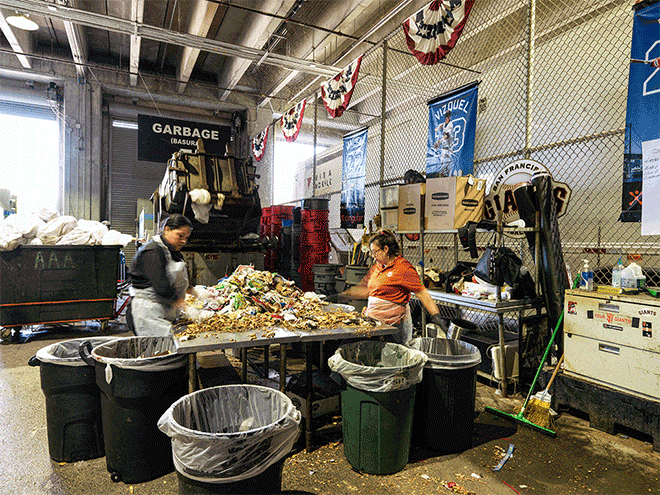
Sorting fans’ trash at AT&T Park’s recycling center.Justin Fantl/Mother Jones
GIVEN THIS LACK of transparency, there’s always the risk that the teams and corporate sponsors joining up with Hershkowitz are just looking for a PR win. “There’s a definite danger for everybody to be co-opted by folks who want to talk green but don’t want to do anything about it,” says Jack Groh, who’s been running the Super Bowl’s greening efforts since 1993. A few years ago, for example, Monsanto tried to convince the NHL to let it be the sport’s main sustainability sponsor. At the league’s request, Hershkowitz laid out the deal’s pros and cons; ultimately, it decided to pass. “You’ve got to walk the walk,” he says. “You’ve got to be doing the stuff, and it’s got to be authentic.”
And then there’s NASCAR. With its enormous fan base and bad enviro optics — a race weekend can burn more than 5,000 gallons of fuel — America’s largest spectator sport comes up again and again with Hershkowitz. NASCAR country is where he sees the biggest potential for growth and change — a true test of his vision of seamlessly packaging a serious environmental message inside mainstream culture.
He has even dispatched his Presidio B-schoolers to consult with five tracks on their recycling programs as part of NASCAR Green, the sport’s environmental-awareness campaign. It hasn’t been easy, as is evident when his students report back to him in class one day. In Alabama, home to the Talladega Superspeedway, just 8 percent of trash is recycled or composted. (The national recycling rate is almost 35 percent.) The owners of the Texas Motor Speedway in Fort Worth have made millions in royalties from fracking wells on their property — not an encouraging sign of their interest in going green. One student reports that an official dismissed his track’s lousy recycling rate, saying, “You know we don’t give a shit about this.”
As his students tick off the problems they’ve been butting up against, Hershkowitz’s shoulders slump. He’d started the Presidio-linked project in hopes of convincing NASCAR to go zero-waste. “Now,” he says, shaking his head, “we’re trying to convince tracks to recycle a bale of aluminum.”
But it’s not like Hershkowitz to give up easily. When I mention to him that my dad and his best buddy used to make an annual summer trip to Pocono Raceway in Pennsylvania, his eyes light up. I can almost see him rifling through the stats in his head: In 2010, the track installed 25 acres of solar panels that will produce 72 million kilowatt-hours of electricity over 20 years, offsetting 3,100 metric tons of carbon dioxide a year. “We’ve got to go to a race together,” Hershkowitz says, eagerly. “They fucking love me at Pocono.”

Allen Hershkowitz.Natalie Keyssar/Mother Jones
